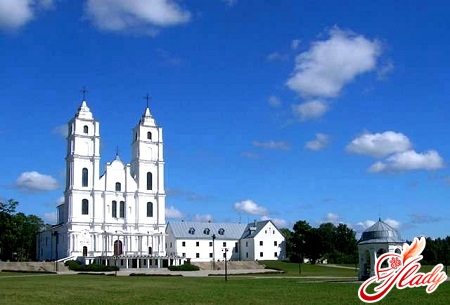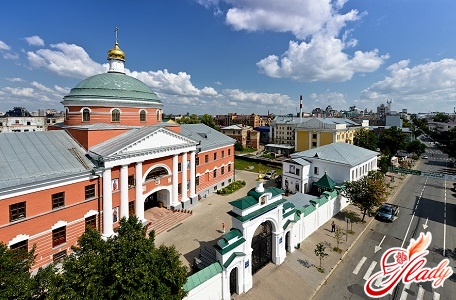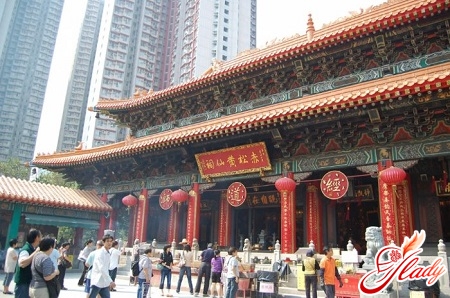
Latvia is a small cozy countrycoast of the Baltic Sea. If you decide to get to know this country and see the main sights of Latvia, then be sure to first visit its capital - Riga. Find a glass booth with a large wooden statue of a man holding a child on his shoulder inside, and learn the legend of the founding of this fabulously beautiful city.
Town Hall Square
This is one of the most beautiful squares in Riga.This is where many city tours begin. Before the Town Hall was built, there was a city market here in the Middle Ages, which is why its old name was Market Square. Currently, it is the political center of Riga, housing the City Council and the City Hall. The most beautiful building on the square is the House of the Blackheads, built in 1334, then destroyed during World War II and restored in 2001 for the 800th anniversary of Riga. Various events, balls, and concerts are held in the halls of the house. A significant landmark of the capital of Latvia is St. Peter's Church, 123.5 meters high, considered the tallest building in the city and its symbol. On the spire of the church there is a figurine of a golden cockerel, which is not only a decoration, but also a weather vane. There are observation decks on the tower, climbing which everyone can enjoy the panorama of Riga. Inside the cathedral there is an unusual wooden altar and displays of ceramics.
Dome Square
Visit the Dome Square and be amazed by its grandeurand admire the architectural ensemble. This square is called the heart of Riga, and the Dome Cathedral, which stands on it, founded in 1211 by Bishop Albrecht von Buxhoeveden, is a landmark of Latvia. The cathedral was rebuilt several times, and therefore its modern appearance, which was formed by the 18th century, includes various architectural styles: Gothic, Baroque, Renaissance and even Romanesque. This is the tallest building in the city, as the height of the tower with a dome and a cockerel on the spire is 96 meters. In the concert hall of the Dome Cathedral there is a magnificent 25-meter organ, which was played by outstanding organists of the world, and famous composers such as Max Reger and Franz Liszt wrote their works especially for it. To this day, this organ is considered unique in its sound. The Riga Cathedral also houses the Riga History and Navigation Museum, founded in 1773, which houses over 500,000 exhibits related to the history, culture of Riga and Latvian navigation. An equally significant landmark of Latvia is the Riga Castle on the Castle Square, which has been destroyed and rebuilt several times. This is a place with extraordinary 14th-century architecture and an amazing history. Currently, it houses the Presidential Palace, on which the flag of the Republic of Latvia flies. The Three Brothers is an ancient architectural ensemble consisting of three stone houses on Mazā Pils Street. The oldest of the three brothers was built in the 14th century, the others were built in the 17th and 18th centuries. Through the gate, you can get into their common courtyard, the wall of which is decorated with the oldest coat of arms of Riga. In the Museum of Baltic Jewellery you will feel the touch of antiquity and learn what the townspeople adorned themselves with 800 years ago. In one part of the museum, originals and copies of ancient jewellery are presented, and in the other, there is a shop selling modern items stylised as ancient ones.
To Riga with children
Take your kids on a trip and show theminteresting sights of Latvia. They will enjoy admiring the funny monuments and buildings, of which there are a great many in Riga alone. These include the “Bremen Town Musicians”, donated by the city of Bremen, and Roland - a knight symbolizing order and law, and Big Christopher - the defender of the city, and the “Chimney Sweep and Mason”, and the “Laima” clock, under which Rigans and guests of the capital have been making dates for almost 100 years, and the yellow building with the coats of arms of Latvian cities on the end, and even the House with Cats, which also has its own legend. LIVU Aqua Park is also a landmark of Riga. This 25-meter-high building has an interior design in the Caribbean style. In the picturesque Mezaparks, on the shore of Lake Kisozero, a 20-minute drive from the center of Riga, the Riga Zoo is open to visitors all year round. It offers to see 475 species of animals and take part in both sightseeing tours and thematic excursions. Not far from Riga, just half an hour away, there is another unusual place. This is the Latvian Ethnographic Museum - the largest open-air museum in Europe. There you can get acquainted with the life and traditions of Latvian peasants and fishermen, learn a lot of interesting things about ancient crafts, take part in festive events, fairs and even make jewelry with your own hands. Having become better acquainted with this Baltic country, you will understand that not all of its attractions are concentrated only in the capital. Go outside Riga, and you will get many more vivid impressions. Riga seaside 20 km from Riga lies the resort town of Jurmala with numerous fashionable sanatoriums, mud baths, beaches. You can visit this resort at any time of the year. Take a stroll along the well-kept streets, look at the old wooden houses - the creations of Latvian, German, Russian and Finnish architects, treat yourself with mineral water and breathe in the fresh sea air. Visit the beach in Majori and find a local landmark there - a sculpture of a triple turtle. Locals are sure that if you touch it, then everything you wish for will certainly come true. By the way, a blue flag is hung on the beaches of Majori and Jaunkemeri - a symbol of quality and safety. 100 meters from the coast of the Gulf of Riga is the Dzintari Concert Hall, with an open hall for 2,000 seats and an indoor hall for 460 seats. The complex also includes a park with well-kept paths, a fountain and benches. Classical music concerts, music competitions and festivals are held in the Dzintari Hall. For example, "New Wave" is a competition for young aspiring performers, which is already known not only throughout Europe, but also beyond its borders.
Liepaja - the city of sea breezes
On the Baltic Sea coast, 50 km from the borderLiepaja, the third largest city in Latvia, is located on the outskirts of Lithuania. The historical center of the city is home to many churches, buildings of various architectural styles, parks and squares. Rose Square is located in the center of Liepaja and is a popular gathering place for young people. It is a rose garden that was laid out on the site of a former market square. Along the edges of the flower beds are signs of Liepaja's sister cities. In the summer, city tours depart from here for everyone. The Holy Trinity Church is the most monumental landmark in Liepaja. The church was consecrated in 1758, and in 1779 it received an organ built by the famous H. A. Concius. To this day, this instrument is one of the largest in Europe. The interior of the church is done in the Rococo style. Liepaja Seaside Park is one of the largest in Latvia and is a favorite walking place for both city residents and guests. The area of the territory is 70 hectares, and the length is 3 km. More than 140 species of trees and shrubs grow in the park. Various festivals are held on the concert stage, and the installed large drums are a landmark of Latvia and a symbol of Liepaja as the musical capital of the country. Visitors have the opportunity to play tennis or mini-golf, ride skateboards, sit in cozy cafes, admire the beautiful fountain and go through the park to the beach.
Mysterious Ventspils
Ventspils is the oldest port cityand a modern resort. In the city center there is the Market Square, where you can buy interesting souvenirs, paintings and jewelry at attractive prices. The Orthodox Church of St. Nicholas represents the neo-Byzantine architectural style of Ventspils, and the Lutheran Church of St. Nicholas - the style of late classicism. The main historical attraction of the city is the Ventspils Castle of the Livonian Order, built by German knights and well preserved to this day. Visitors have the opportunity to get acquainted with the history and legends of the castle in a unique museum, immerse themselves in the atmosphere of the Middle Ages, take part in archery and even shoot a cannon. Ventspils - for children On the outskirts of Ventspils, the Seaside Park is open, a favorite place for walks and picnics for locals, where you can ride a train called "Kukushka". Such a trip will bring pleasure not only to children, but also to adults. There is an open-air ethnographic museum on the park’s territory, where you can get acquainted with the life of the inhabitants of the sea coast. The children’s town in Ventspils can also be considered a landmark of Latvia and a source of pride for local residents. There are attractions installed on more than 40 playgrounds. Each playground is dedicated to a city in the world, and these cities can be found on a huge globe at the entrance to the park. The park also has popular rope attractions designed for different age groups. Latvia is waiting for you! This small European country has an ancient history, interesting customs and traditions. It attracts tourists not only with its amazing nature, forests, parks, white sand beaches, but also with a large number of attractions that will not leave anyone indifferent.









